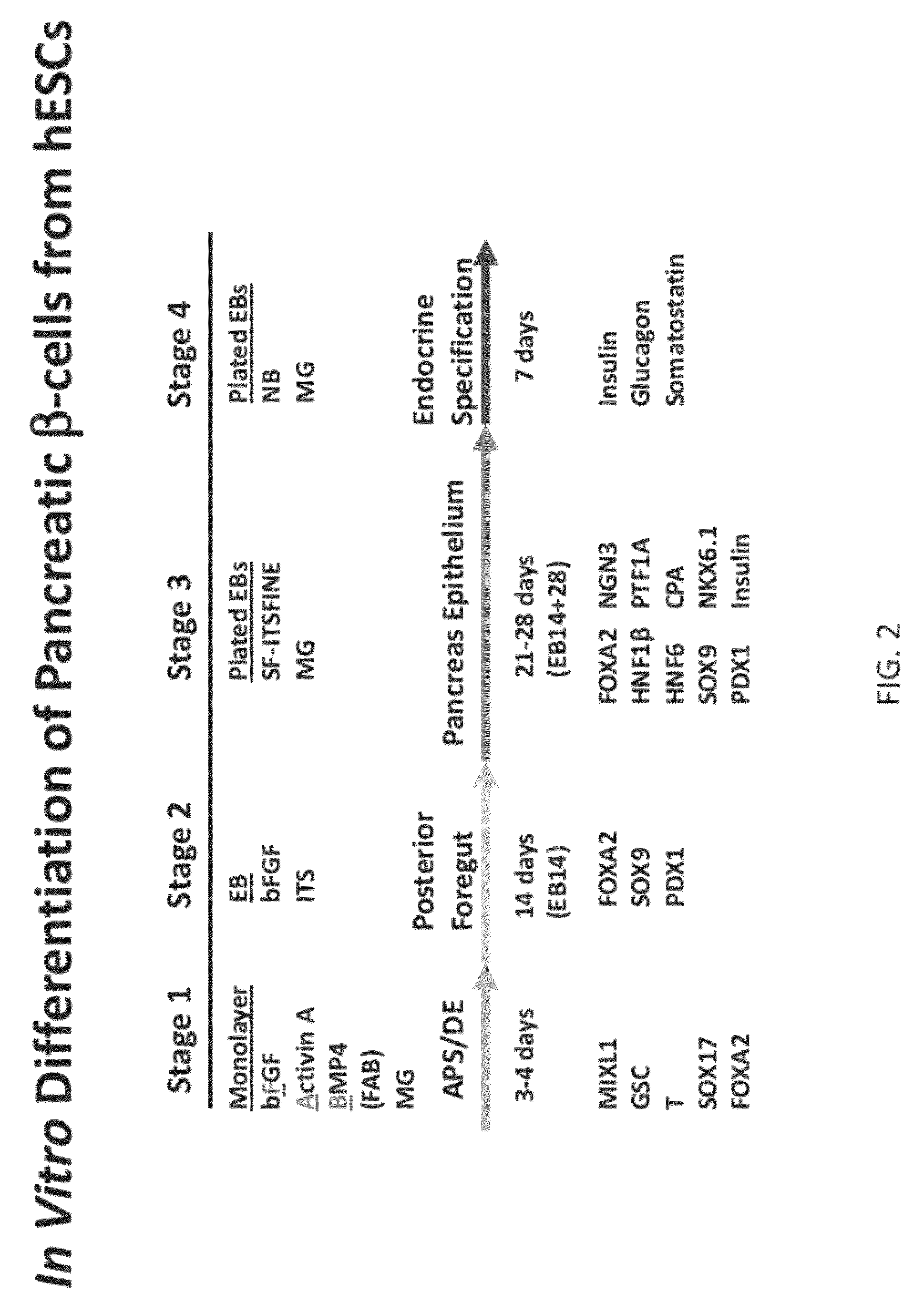Methods and devices for differentiating pluripotent stem cells into cells of the pancreatic lineage
a technology of pancreatic lineage and stem cells, which is applied in the direction of cell culture active agents, embryonic cells, artificial cell constructs, etc., can solve the problems of limited amount of human cadaver islet cells which can be harvested, limited experimental methods used to achieve such observations, and limited patient-specific effects
- Summary
- Abstract
- Description
- Claims
- Application Information
AI Technical Summary
Benefits of technology
Problems solved by technology
Method used
Image
Examples
example 1
[0065]The genes and intercellular signaling molecules controlling definitive endoderm and pancreas development in vertebrates are rapidly being elucidated. This knowledge has informed the establishment of methods for generating such cells from human ES and iPS cells in vitro. Based on the defined roles of nodal / Activin signaling in definitive endoderm development, we have identified a protocol using Activin A, BMP4, and bFGF in chemically defined, serum-free media which efficiently directs human pluripotent stem cells into an enriched population of definitive endoderm that can be differentiated in EB suspension cultures to produce a homogeneous population of foregut and pancreatic progenitors, including PDX1 and Sox9 expressing cells. Under defined conditions, a proportion of progenitors ultimately give rise to insulin+ / C-peptide+ / PDX1+ / β-like cells as well as cells expressing other endocrine hormones in vitro.
[0066]Materials and Methods
[0067]Culture of undifferenti...
example 2
Alternate Protocol
[0104]As depicted in FIGS. 1 and 20, rather than suspending EBs from Stage 2 in Matrigel™ on coverslips, an alternate method has been developed to establish long-lived pancreatic / foregut progenitor cells. Here, EBs developed as described above in Example 1 were taken after Stage 2, prepared as described in Stage 3, but rather than seeding on coverslips, the Matrigel-embedded cells were seeded on Transwell™ inserts (Corning) in ITSFINE medium. Similar to Stage 3 under the Standard Protocol, medium was refreshed every other day.
[0105]It was discovered that EB-derived cells cultured in this way were enriched in PDX1+ / Ins− cells, which were maintained in a stable culture up to 112 days from Stage 1 (FIG. 21). In contrast, if cells are maintained in Stage 3 conditions of the Standard Protocol for more than 3-4 weeks, PDX1+ / Sox9+ progenitors are lost (data not shown). It is believed that this Alternate Protocol may prove very useful for accelerating the process for suppl...
example 3
Induced Pluripotent Cells
[0107]Similar to Example 1, which focused on hESCs, hiPS cells including iPS (Foreskin), clone 1, lot name: iPS (Foreskin)-1-DL-1, iPS (IMR90), clone4, lot name: iPS (IMR90)-4-DL-1, and iPS-DF19-9, clone 7T, lot number: iPS-DF19-9-7T-MCB-01 were successfully differentiated through Stage 3 following the Standard Protocol of Example 1. As seen in FIG. 22, immunostaining revealed that hiPS cell pancreas spheres expressed the same markers of differentiation and in the same temporal pattern as hESCs cultured in parallel.
PUM
| Property | Measurement | Unit |
|---|---|---|
| size | aaaaa | aaaaa |
| total time | aaaaa | aaaaa |
| concentrations | aaaaa | aaaaa |
Abstract
Description
Claims
Application Information
 Login to View More
Login to View More - R&D
- Intellectual Property
- Life Sciences
- Materials
- Tech Scout
- Unparalleled Data Quality
- Higher Quality Content
- 60% Fewer Hallucinations
Browse by: Latest US Patents, China's latest patents, Technical Efficacy Thesaurus, Application Domain, Technology Topic, Popular Technical Reports.
© 2025 PatSnap. All rights reserved.Legal|Privacy policy|Modern Slavery Act Transparency Statement|Sitemap|About US| Contact US: help@patsnap.com



